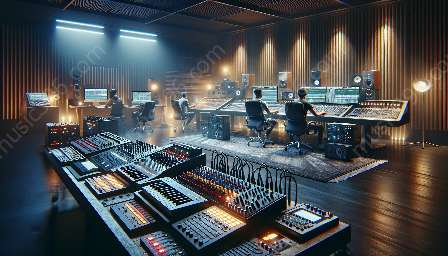Music Information Retrieval (MIR) is a multifaceted field that combines music, technology, and data analytics to enhance our experience of sound. In recent years, MIR has made significant contributions to areas such as immersive audio experiences and virtual reality environments, revolutionizing how we perceive and interact with music. This article sets out to explore the intersection of MIR, immersive audio experiences, and virtual reality, highlighting the technological advancements and innovative applications that are reshaping the landscape of audio and music.
Understanding Music Information Retrieval
Before delving into the impact of MIR on immersive audio experiences and virtual reality environments, it's crucial to grasp the fundamental concepts of MIR. Essentially, MIR involves the development of algorithms and systems to extract meaningful information from music data. This can encompass tasks such as music classification, audio feature extraction, music similarity analysis, and automatic music recommendation systems. MIR leverages a combination of signal processing, machine learning, and human-computer interaction techniques to interpret, organize, and retrieve music-related data.
Enhancing Immersive Audio Experiences
One of the most compelling ways in which MIR contributes to immersive audio experiences is through spatial audio processing and rendering. By employing MIR algorithms, audio engineers can create immersive soundscapes that simulate three-dimensional auditory environments, enveloping listeners in a rich and dynamic audio experience. This approach is particularly relevant in virtual reality settings, where accurate spatial audio enhances the sense of presence and realism, transporting users to virtual worlds with heightened auditory immersion.
MIR also plays a pivotal role in personalized audio experiences, catering to individual preferences and context-specific listening scenarios. Through the analysis of user listening behavior, MIR systems can generate tailored playlists, recommend relevant tracks, and adapt audio parameters to match the user's spatial and perceptual preferences. This tailored approach to immersive audio amplifies engagement and emotional connection, cultivating a deeply personalized sonic environment for each listener.
Empowering Virtual Reality Environments
Virtual reality (VR) relies heavily on audio to create realistic and compelling experiences, and MIR is instrumental in shaping the auditory aspects of VR environments. By integrating MIR techniques, VR content creators can synchronize audio with visual elements, ensuring seamless coordination and alignment between the two modalities. This synchronization is vital for maintaining immersion and coherence within VR experiences, enriching the overall sense of presence and believability.
Furthermore, MIR contributes to the dynamic adaptation of audio in VR environments, accommodating user interactions and environmental changes. Through real-time analysis and processing of audio data, VR systems can adjust sound attributes based on user movements, spatial positioning, and environmental factors, delivering a responsive and interactive auditory experience. This capability adds depth and realism to virtual worlds, fostering a heightened sense of presence and interactive engagement for VR users.
Integrating Music Technology for Enhanced MIR
Within the realm of MIR, music technology serves as a catalyst for innovation, pushing the boundaries of audio processing and retrieval. Recent advancements in music technology, including deep learning-based audio analysis, virtual acoustics modeling, and cognitive music informatics, have bolstered MIR capabilities and expanded the possibilities for immersive audio and VR applications.
Deep learning algorithms, in particular, have revolutionized MIR by enabling more nuanced and sophisticated analysis of music content. Through neural network architectures, MIR systems can extract intricate audio features, detect musical patterns, and synthesize complex audio representations, elevating the fidelity and expressiveness of immersive audio experiences in virtual reality.
The Future of MIR and Immersive Audio in VR
Looking ahead, the synergy between MIR, immersive audio, and virtual reality is poised to drive transformative developments in the entertainment, gaming, and communication industries. As the demand for interactive and emotionally resonant audio experiences continues to grow, MIR will be at the forefront of delivering personalized, spatially immersive, and context-aware audio solutions for virtual reality environments.
Furthermore, the convergence of MIR with emerging technologies such as augmented reality, spatial computing, and haptic feedback promises to expand the horizons of auditory immersion in both real and virtual spaces. This evolution holds immense potential for creating sensory-rich environments that blur the boundaries between physical and digital realms, offering compelling audio experiences that captivate and inspire users across diverse domains.
Conclusion
The fusion of music information retrieval, immersive audio experiences, and virtual reality represents a paradigm shift in the way we engage with auditory stimuli. Through the synergy of innovative MIR techniques and cutting-edge music technology, we are witnessing a new era of audio experiences that transcend conventional boundaries, captivating our senses and reshaping our perceptions of sound in immersive and virtual environments.

























